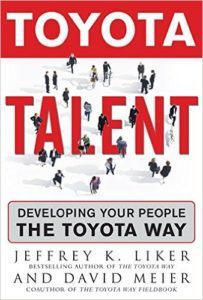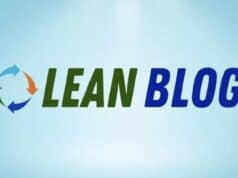I responded to a question that was posed on the NWLean email/web group. It asked about the use of the phrase “standardized work” instead of “standard work.” Was this like “preventive maintenance” instead of “preventative maintenance?”
I think there *is* a key distinction in standardized instead of standard.
As I wrote here, I have moved toward using “Standardized” almost exclusively in the last year (or at least I try) The word “standard” seems to imply inflexible, an absolute set of steps. “Standardized” is more of a direction — it's somewhat standardized, but there might still be room for judgment in how the work is done. “Standard” says “you do maintenance at 10 AM, no matter what” while “Standardized” implies “do it at 10 AM if possible, but do it a bit earlier or a bit later, if customer needs mandate it.” To me, “standardized” gives more leeway for professional judgment, whether a surgeon, medical laboratory technologist, or subway maintenance tech.
 The book Toyota Talent
The book Toyota Talent gives a good description of this mindset:
We don't want “standard” for the sake of standard. It should be “standardized,” not necessarily “identical” and absolute. We standardize processes that should be standardized for the sake of quality, safety, cost, etc
We have to standardize to the right level of detail. Too often, it seems people go and standardize without thinking through “why.” If you standardize without explaining why or it's forced on people, they'll resist and maybe understandably so.
Please scroll down (or click) to post a comment. Connect with me on LinkedIn.
Let’s build a culture of continuous improvement and psychological safety—together. If you're a leader aiming for lasting change (not just more projects), I help organizations:
- Engage people at all levels in sustainable improvement
- Shift from fear of mistakes to learning from them
- Apply Lean thinking in practical, people-centered ways
Interested in coaching or a keynote talk? Let’s talk.
Join me for a Lean Healthcare Accelerator Trip to Japan! Learn More










We usually use “Standard Work”. We work to high standards!
The reason for this is, in our experience, people don’t like to be “-ized”. The idea that “we’re going to develop work standards” sounds more appealing than “we’re going to standardize your work”. We try to think of the customers of the standard work, and how the words sound to them…
The other distinction between the two is that I usually think of “Standardized Work” in the context of Toyota’s 3 characteristics: Takt time, Standard WIP, Standard Work Sequence. Most of the time I’m working with people to develop the standard work sequence, and this I call Standard Work. In my opinion, most companies are nowhere near ready for Toyota’s level of standardized work, and would be best served to just focus on getting the standard work sequence right…
I still hold with “standard work” as opposed to “standardized work” even though I know the latter is the English phrase Toyota has chosen. Technically, Toyota’s phrase is an incorrect Japanese > English translation.
A standard is a reference point against which other things can be evaluated or compared. When something is standardized, it is brought into conformity with a standard. When you document standard work, you are defining the reference point based on takt time, work sequence and standard work in process. When you standardize work, you are simply copying such a standard. Standardized work can mean work that conforms to any standard, whether it is defined by takt, work sequence and SWIP or without those elements but simply by work instructions.
What we call “standard work / standardized work” has not been “brought into conformity with a standard” of any kind, in terms of a target time or defined method. Instead it is the standard method itself, reviewed and updated regularly through kaizen. A new standard is set for this work, but there is no objective standard to which work has been “standardized”.
The direct translation of the Japanese hyoujyun sagyou is “standard work” and it is my belief that “standardized work” is either a poor translation that became the standard at Toyota or a deliberate attempt to reduce confusion with “work standards” which is almost exactly a mirror image of “standard work”.
It would be great to hear the original explanation for why “standardized work” is the chosen English phrase at Toyota.
Good point about confusion with Taylor’s “Work Standards”, which were a result of the “stopwatch men” who viewed work simply by how long it took to do. I don’t think this was Taylor’s intent, nor the intent of his close followers, but the majority of people applying what they called Scientific Management were really just trying to get people to work faster and harder.
The burdon of that experience on American industry is something we now need to un-do with Lean.
Luckly most people who work in my organization have never heard of Fredrick Taylor and know nothing of the history of “work standards”, so the baggage associated with it is not an issue.
The term Work Standards or Standard Work fits well with a problem solving approach. In problem solving, we define a problem as a deviation from a standard. The closer we associate “standard work” with the kinds of standards we think of in problem solving, the closer we are to defining how the whole system works. Standard Work is the standard, and when its not met, that’s officially a problem. It’s also the standard we associate with control groups in the scientific method. As we think of improvements as being experiments, the idea of Standard Work being the control group for comparison makes a lot more sense to people.
One thing I think our community does not take advantage of enough is the prevalence of people’s basic understanding of the scientific method. Most people learn about it in school or perhaps by helping their kids with a science fair. As I work with different groups from the shop floor, I can ALWAYS get the group to derive all the steps of the scientific method. We jump through all these hoops trying to explain what Lean is, and most people have a basic understanding already that simply needs to be reactivated or refreshed.
My understanding is that “standard work” is a key element of Lean management as a means of focusing defined activities. Standard work is not ‘timed’ but you may have to complete the task at a certain ‘time’ per day. Example, start-up meeting at the beginning of shift. However, “standardized work” is about establishing best practice, defining work elements, and training people to ensure the same methods are used across different operators/shifts.
Here’s a comment from a Toyota person on LinkedIn:
This is a very good definition of the difference in the three. They are commonly confused in the industry resulting in miss understandings like they are the same thing just a different name.
Standardized Work should be a tool used by the industry to manage the human resources needed to produce the product for the customer. It establishes labor hours per piece, which can be used as a KPI of success. This is why we commonly hear it is the standard for stabilization and foundation for Kaizen. I have always looked at Standardized Work as a living process to manage and improve the labor content in a product.